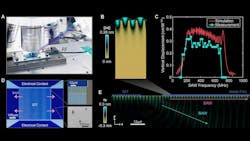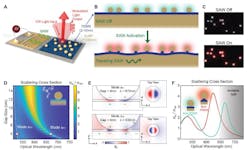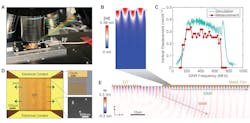Acoustic Metasurface, IDT Modulates Light at Gigahertz Rates
What you’ll learn:
- How a Stanford University research team used acoustic waves to manipulate light.
- Device implementation involving gold nanoparticles placed in a particle-on-mirror configuration with a compressible polymer spacer.
- Adding an interdigitated transducer (IDT) as an ultrasonic speaker to produce high-frequency sound waves.
The convergence of interactions among optics, acoustics, and electronics leads to some fascinating research advances. A good example of this interplay is seen in recent work at Stanford University, where a team devised a novel way to use acoustic waves to manipulate light that has been confined to gaps only a few nanometers across. It resulted in detailed control over the color and intensity of light via mechanical means.
(They also acknowledge that this new device isn’t the first to manipulate light with sound, but it’s smaller and potentially more practical and powerful than conventional methods.)
In brief, the team placed gold nanoparticles in a particle-on-mirror configuration with a few-nanometers-thick, compressible polymer spacer. Surface acoustic waves (SAWs) driven by an interdigital transducer (IDT) were then used to tune light scattering at speeds approaching the gigahertz region.
The SAWs produced mechanical deformations in the polymer, and the resulting nonlinear mechanical dynamics led to unexpectedly large levels of strain and spectral tuning. Their approach provides a design strategy for electrically driven dynamic metasurfaces and fundamental explorations of high-frequency, polymer dynamics in ultra-confined geometries.
SAWs + Gap Plasmons to Manipulate Light
Of course, the full story is more complicated than that relatively simple description. Their objective was to devise ways to electrically manipulate the optical resonances of metallic nanostructures in nanophotonics and do so at a high speed.
To achieve this, they used electrically driven SAWs and the extreme light concentration offered by gap plasmons. The SAWs produced mechanical deformations in the polymer, and the resulting ensuing nonlinear mechanical dynamics led to unexpectedly large levels of strain and thus large amplitude spectral tuning.
What is a Plasmon?
A plasmon is a quantum of plasma oscillations. These plasma oscillations, also known as Langmuir waves, are rapid oscillations of the electron density in conducting media such as plasmas or metals in the ultraviolet region. Just as light — an optical oscillation — consists of photons, the plasma oscillation consists of plasmons.
The new device is deceptively simple, with gold nanoparticles placed in a particle-on-mirror configuration with a compressible polymer spacer (Fig. 1). Specifically, a thin gold mirror is coated with an ultra-thin layer of a rubbery, silicone-based polymer only a few nanometers thick. The research team could fabricate the silicone layer to desired thicknesses, anywhere between 2 and 10 nm (for comparison, the mid-band wavelength of light is around 550 nm).
The researchers deposited an array of 100-nm gold nanoparticles across the silicone. Some analogies help here: The nanoparticles “float” like golden beach balls on an ocean of polymer atop a mirrored sea floor. Light is gathered by the nanoparticles and mirror and focused into the silicone between, shrinking the light to the nanoscale.
But that’s only part of the story. They attached an interdigitated transducer as an ultrasonic speaker to the side and sent high-frequency sound waves rippling across the film at nearly a gigahertz (Fig. 2). The SAWs surf along the surface of the gold mirror beneath the nanoparticles. The elastic polymer acts like a spring, stretching and compressing as the nanoparticles bob up and down while the sound waves pass by.
Squeezing the Light
When the researchers shined light into the system, this light gets “squeezed” into the oscillating gaps between the gold nanoparticles and the gold film. Although the gaps change in size by just the width of a few atoms, it’s enough to produce an outsized effect on the light. The size of these gaps determines the color of the light resonating from each nanoparticle. The researchers controlled the gaps by modulating the acoustic wave and therefore controlled the color and intensity.
The result is a series of flickering, multicolored nanoparticles against a black background, like stars twinkling in the night sky. Any light that doesn’t strike a nanoparticle is bounced out of the field of view by the mirror, and only the light that’s scattered by the particles is directed outward toward the human eye. Thus, the gold mirror appears black, and each gold nanoparticle shines like a star.
One obvious question is what applications might use this arrangement. Short answer: Not sure, it’s all highly speculative. Possible, applications include ultra-thin screens, 3D holographic imagery, optical communications, and ultra-fast light-based neural networks. You just never know when it comes to these sorts of advances and techniques.
The work is detailed in their paper “Acoustic wave modulation of gap plasmon cavities” published in Science. While that paper is behind a paywall, it does include open links to three short videos as well as supplementary material. Fortunately, the “student version” of the entire paper as published is also posted at Arvix, but without the video links.
About the Author

Bill Schweber
Contributing Editor
Bill Schweber is an electronics engineer who has written three textbooks on electronic communications systems, as well as hundreds of technical articles, opinion columns, and product features. In past roles, he worked as a technical website manager for multiple topic-specific sites for EE Times, as well as both the Executive Editor and Analog Editor at EDN.
At Analog Devices Inc., Bill was in marketing communications (public relations). As a result, he has been on both sides of the technical PR function, presenting company products, stories, and messages to the media and also as the recipient of these.
Prior to the MarCom role at Analog, Bill was associate editor of their respected technical journal and worked in their product marketing and applications engineering groups. Before those roles, he was at Instron Corp., doing hands-on analog- and power-circuit design and systems integration for materials-testing machine controls.
Bill has an MSEE (Univ. of Mass) and BSEE (Columbia Univ.), is a Registered Professional Engineer, and holds an Advanced Class amateur radio license. He has also planned, written, and presented online courses on a variety of engineering topics, including MOSFET basics, ADC selection, and driving LEDs.


